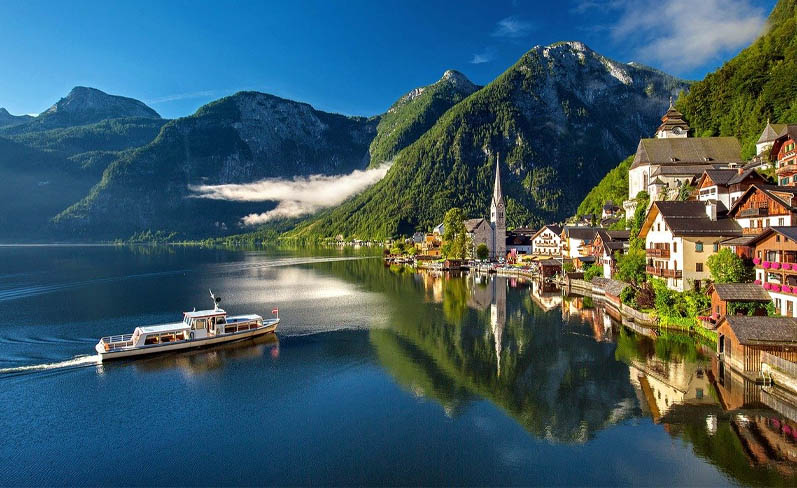Austria
A warm welcome along with high standards of service and facilities awaits you on your holiday to Austria, rich in culture and heritage, Austria sits in a stunning Alpine landscape with snow-capped peaks, rolling meadows and gingerbread chalets. Imperial and Baroque cities including Vienna, the capital, and Salzburg are famed for their musical heritage and stunning architecture and are ideal for a city break. Tucked away in the mountains, holiday resorts in Austria such as Kitzbuhel and Zell Am See offer a fantastic range of winter and summer sports and are ideal for a family holiday, you may experience the rich musical heritage on your holiday to Austria.
Highlights
Elegant palaces and convivial coffee houses are a hallmark of this landlocked Central European nation, where lakes and mountains also provide a multitude of soft or adrenalin-packed adventures.
When to Visit
Austria has a temperate climate with four distinct seasons. However, due to its size and varied geography, there are a couple of distinct climatic regions that stand out – in the east, the Pannonian climate dominates with low rainfall, hot summers and moderate winters, while in the Central Eastern Alps, you should expect an Alpine climate of high rainfall, short summers and long winters. December-March is peak ski season.
Attractions
Vienna
Austria’s capital is also one of the best cultural cities in Europe, thanks to its array of museums, not to mention spacious parks, excellent restaurants, cafe culture and nightlife. Brilliantly for visitors, the city’s key museums are gathered in MuseumsQuartier within an array of historic and contemporary buildings. The ctiy has also been dubbed “the world’s best city to live in”, thanks to continuous top marking by the 18th Mercer Quality of Life study. The Vienna Jugendstil, or Art Nouveau, period around 1900 is a key cultural facet, leaving behind a legacy of ornate architecture, design and artists such as Gustav Klimt and Egon Schiele. The city is also known for its Imperial palaces, including stunning Schonbrunn, the Habsburgs’ summer residence, and Hofburg. Vienna can also boast its own thermal spa - Oberlaa Therme, offering thermal baths and a wellness area.Austria’s capital is also one of the best cultural cities in Europe, thanks to its array of museums, not to mention spacious parks, excellent restaurants, cafe culture and nightlife. Brilliantly for visitors, the city’s key museums are gathered in MuseumsQuartier within an array of historic and contemporary buildings. The ctiy has also been dubbed “the world’s best city to live in”, thanks to continuous top marking by the 18th Mercer Quality of Life study. The Vienna Jugendstil, or Art Nouveau, period around 1900 is a key cultural facet, leaving behind a legacy of ornate architecture, design and artists such as Gustav Klimt and Egon Schiele. The city is also known for its Imperial palaces, including stunning Schonbrunn, the Habsburgs’ summer residence, and Hofburg. Vienna can also boast its own thermal spa - Oberlaa Therme, offering thermal baths and a wellness area.
Central Austria
Head west of Vienna for the Wachau Valley, which is known for its rolling hills, vineyards, fortresses and castles, and along the way, stops should include the monastic magnitude of Melk Abbey, with its grand baroque church. Over in Linz, there are more baroque charms, as well as the riverside Lentos Kunstmuseum, which has an enviable modern art collection. But Salzburg is of course the real celebrity here - in particular its old town, or Altstadt, which is listed as a UNESCO World Cultural Heritage Site thanks to its unique collection of Medieval and baroque buildings. Also here, you will find the Hohensalzburg fortress, seen as being Austria's most impressive medieval castle. Mozart was from Salzburg, so expect to see his face and hear his music a lot. And not forgetting of course, the area is known for its role in The Sound of Music, the musical movie set around the life of the Von Trapp family. Once you have sung Edelweiss, head less than 100km south to Bad Gastein, a 19th-century spa town in the High Tauern mountains. Back over in the east is the country’s second largest city, Graz, which has been strategically important over the years and is now home to a great cultural and design reputation.
Western Austria
The long skinny western stretch of Austria runs between Germany to its north and Italy to the south, with the mountain state of Tyrol attracting many visitors enraptured by the majesty of the Alps, including the country’s highest mountain, Hoher Tauern. In Tyrol, you'll find some of Austria’s key ski spots, such as Lech, Kitzbuhel, Mayrhofen, Ischgl and St Anton, springboard for Arlberg, considered the best ski region in the country. The regional capital of Innsbruck holds plenty of charm away from the slopes too, such as Habsburg Empire landmarks like Hofburg Palace and Gothic Hofkirche Church, as well as the 15th-century Goldenes Dachl, a loggia shimmering with copper tiles commissioned by Emperor Maximilian I.
Wildlife
Austria is one of Europe’s most heavily wooded countries and has variety of wildlife, such as deer, stag, rabbit, pheasant, fox, badger, marten and partridge. There is even a small bear population in the southern and central mountainous regions. Native to its alpine regions are creatures such as the chamois, groundhog, eagle and mountain jackdaw. In the reed beds of the Neusiedler See – a large lake shared with Hungary to the east – you’re likely to see heron, spoonbill, scooper and wild geese. It’s known also for its pretty alpine flora such as edelweiss, alpine carnation, heather, arnica and alpine rose.
